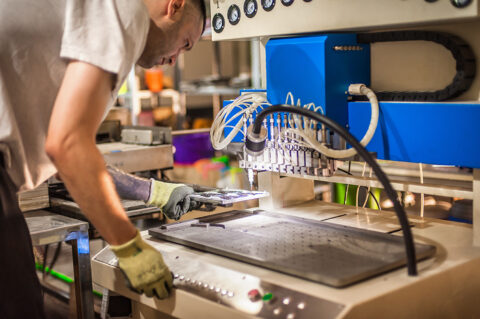If you’re looking for signs that the U.S. manufacturing sector is at a crossroads, this past week delivered a full spectrum of evidence. On one hand, we saw continued contraction in key industry indicators—most notably, the ISM Manufacturing Index fell for the fifth straight month, with employment hitting its lowest level since the pandemic. On the other, we witnessed a wave of bold capital investment: Micron’s $200 billion domestic chip expansion, Mars’ $2 billion bet on U.S. facilities, and continued commitment from GM to scale both EV and traditional vehicle production. These moves affirm a long-term reshoring trend, even as near-term pressures mount.
The backdrop to it all? Trade disruption. A sweeping new set of tariffs announced August 1 introduces cost volatility across 66 countries—Canada and the EU included—creating both risk and recalibration for U.S. supply chains. Economists warn these measures could raise input costs by up to 4.5%, hitting small manufacturers hardest and complicating efforts to invest in AI, automation, and workforce expansion. It’s a reminder that tariffs, while strategically useful in leveling the playing field, must be paired with clear policy support for domestic capacity building—especially for the 250,000 manufacturers under 500 employees.
Meanwhile, job growth across the economy is slowing. The latest jobs report showed sluggish hiring and a rising unemployment rate, signaling tightening conditions that small manufacturers will feel first. But even in this uncertain environment, the direction remains clear: major firms are betting on American production, and smart manufacturing tech continues to promise new efficiency and resilience.
The question now is how quickly the ecosystem can adapt. Investment is flowing. Policy is shifting. But the path ahead demands alignment—between strategy, technology, and the deeply relational foundation of American manufacturing. We’re still early in this 20- to 30-year shift. But the stakes are already real.
🔧 Main Stories
U.S. Manufacturing Shrinks for Fifth Straight Month
The ISM Manufacturing PMI dropped to 48.0 in July—well below the 50-point growth threshold—with factory employment falling to 43.4, its lowest level since July 2020 (Reuters; PR Newswire).
Why It Matters: The contraction reflects cautious capital spending, tighter demand, and shifting supplier dynamics. Small manufacturers may face delayed orders and harder hiring decisions.
The Bigger Picture: Despite near-term softness, long-term reshoring investments continue—a signal that the downturn is seen as cyclical, not structural.
New Tariffs Could Add 4.5% to Factory Costs
A new executive order imposed 10–41% tariffs on imports from 66 countries, including Canada (35%) and the EU, igniting new uncertainty across U.S. supply chains (AP; Times of India).
Why It Matters: Analysts warn the tariffs could raise input costs by 2–4.5%, squeezing margins and delaying tech adoption, especially in automation and AI.
The Bigger Picture: Strategic use of tariffs can level playing fields—but only if paired with policy tools that help small firms navigate sourcing and cost challenges.
Micron, Mars, and GM Double Down on U.S. Manufacturing
Three major players announced high-profile investments in U.S. production:
-
Micron: $200B in new fabs and R&D across Idaho, NY, and Virginia, funded partly through CHIPS Act credits (Investopedia).
-
Mars: $2B through 2026 to upgrade food, snacking, and pet-care manufacturing (WSJ).
-
GM: Continues $4B investment into ICE and EV plants, part of $10–12B annual spend plan (NY Post).
Why It Matters: These long-term bets reflect confidence in U.S. capability and demand—and provide downstream opportunities for smaller suppliers.
The Bigger Picture: This is the secular reshoring trend in action: distributed, tech-enabled manufacturing capacity rooted in American soil.
⚙️ Quick Hits
-
Jobs Report Misses Mark: July added just 73,000 jobs; unemployment rose to 4.2%, with downward revisions to May/June job totals (WSJ).
-
Sumitomo Expands EV Capacity: $17M investment adds automated wiring harness production in Simpson County, KY (IndustrySelect).
-
ISM Nuance: Production rose to 51.4 even as orders and employment weakened—suggesting short-term unevenness, not collapse (MarketWatch).
-
Smart Manufacturing Tech Gains Ground: New study shows 22% less downtime and 18% energy savings from AI-enabled digital twins and flexible reconfiguration (arXiv).
🔭 Looking Ahead
While the week’s headlines reveal stress in the system, the strategic moves taking shape suggest the U.S. manufacturing sector isn’t retreating—it’s recalibrating. As August unfolds, all eyes will be on:
-
Tariff enforcement and trade retaliation (starting Aug 7),
-
Fresh PMI and jobs data,
-
Progress on CHIPS Act capital deployment.
In a high-stakes moment for U.S. industry, small manufacturers remain the linchpin. Resilience starts with relationships—and ends with the ability to make what matters, right here at home.




